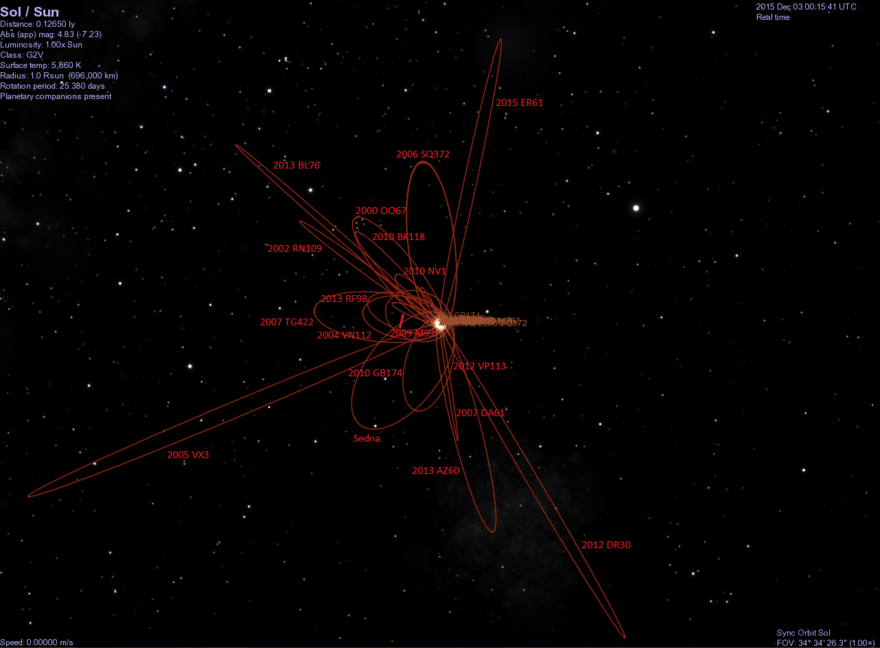2005 VX3
| Discovery[1] | |
|---|---|
| Discovered by | Mt. Lemmon Survey |
| Discovery date | 2005-11-01 |
| Designations | |
| Orbital characteristics[3] | |
| Epoch 13 January 2016 (JD 2457400.5) | |
| Uncertainty parameter 4 | |
| Observation arc | 81 days |
| Aphelion |
3080 ±643 AU (heliocentric) ~2049 AU (barycentric)[lower-alpha 1] |
| Perihelion | 4.1316 AU (618.08 Gm) |
|
1542 ±322 AU (heliocentric) ~1026 AU (barycentric)[lower-alpha 1] | |
| Eccentricity | 0.99745 |
|
60556 ±18970 a ~32900 yr[lower-alpha 1] | |
| 0.055248° | |
| Inclination | 112.389° |
| 255.245° | |
| 196.550° | |
| Earth MOID | 3.1754 AU (475.03 Gm) |
| Jupiter MOID | .853052 AU (127.6148 Gm) |
| Physical characteristics | |
| Dimensions | 7 km (assumed)[4] |
| 27 | |
| 14.1[3] | |
|
| |
2005 VX3 is the minor planet with the largest known heliocentric semi-major axis and aphelion.[5] Additionally its perihelion lies within the orbit of Jupiter, which means it also has the largest orbital eccentricity of any known minor planet. 2005 VX3 has a barycentric semi-major axis of ~1026 AU.[6][lower-alpha 1] 2012 DR30 has a larger barycentric semi-major axis. The epoch of January 2016 was when 2005 VX3 had its largest heliocentric semi-major axis.
2005 VX3 has a short observation arc of 81 days and does not have a well constrained orbit.[3] It has not been observed since January 2006, when it came to perihelion, 4.1 AU from the Sun.[3] It may be a dormant comet that has not been seen outgassing. In the past it may have made closer approaches to the Sun that could have removed most near-surface volatiles. The current orbit crosses the ecliptic just inside Jupiter's orbit and has a Jupiter-MOID of 0.8 AU.[3]
As of 2016, it has an apparent magnitude of ~27 and is 22 AU from the Sun. It would require one of the largest telescopes in the world for any more follow-up observations.
| Different Epochs | |||||||
| Epoch | Heliocentric Aphelion (Q) (AU) | ||||||
|---|---|---|---|---|---|---|---|
| Barycentric 1950 | 2710[lower-alpha 1] | ||||||
| 2012-09-30 | 1914[8] | ||||||
| 2015-06-27 | 2563[9] | ||||||
| 2016-01-13 | 3235[3] | ||||||
| Barycentric 2050 | 2049[lower-alpha 1] | ||||||
Comparison

See also
Notes
- 1 2 3 4 5 6 Given the orbital eccentricity of this object, different epochs can generate quite different heliocentric unperturbed two-body best-fit solutions to the semi-major axis and orbital period. For objects at such high eccentricity, the Sun's barycentric coordinates are more stable than heliocentric coordinates.[7] Using JPL Horizons, the barycentric semi-major axis is approximately 1026 AU.[6]
References
- ↑ "MPEC 2005-V58 : 2005 VX3". IAU Minor Planet Center. 2005-11-08. Retrieved 2014-03-05. (K05V03X)
- ↑ "2005 VX3 Orbit". IAU minor planet center. Retrieved 2014-03-06.
- 1 2 3 4 5 6 "JPL Small-Body Database Browser: (2005 VX3)" (last observation: 2006-01-21; arc: 81 days). Jet Propulsion Laboratory. Retrieved 24 March 2016.
- ↑ "List of Known Trans-Neptunian Objects". Johnston's Archive. 2005-11-08. Retrieved 2014-03-05.
- ↑ "JPL Small-Body Database Search Engine: Asteroids and a > 100 (AU)". JPL Solar System Dynamics. Retrieved 2014-03-06. (Epoch defined at will change every 6 months or so)
- 1 2 Horizons output. "Barycentric Osculating Orbital Elements for 2005 VX3". Retrieved 2014-03-06. (Solution using the Solar System Barycenter and barycentric coordinates. Select Ephemeris Type:Elements and Center:@0)
- ↑ Kaib, Nathan A.; Becker, Andrew C.; Jones, R. Lynne; Puckett, Andrew W.; Bizyaev, Dmitry; Dilday, Benjamin; Frieman, Joshua A.; Oravetz, Daniel J.; Pan, Kaike; Quinn, Thomas; Schneider, Donald P.; Watters, Shannon (2009). "2006 SQ372: A Likely Long-Period Comet from the Inner Oort Cloud". The Astrophysical Journal. 695 (1): 268–275. arXiv:0901.1690
 . Bibcode:2009ApJ...695..268K. doi:10.1088/0004-637X/695/1/268.
. Bibcode:2009ApJ...695..268K. doi:10.1088/0004-637X/695/1/268. - ↑ Archive of JPL Epoch 2012 orbital solution that has aphelion (Q)=1914 AU saved at archive is/GTBp
- ↑ Minor Planet Center archive of Epoch 2015 with aphelion (Q)=2563 AU
External links
- Minor Planet Center archive of Epoch 2015-06-27 with aphelion (Q) of 2563AU
- JPL Webcite archive of Epoch 2016-Jan-13 with aphelion (Q) of 3235AU
- 2005 VX3 at the JPL Small-Body Database
